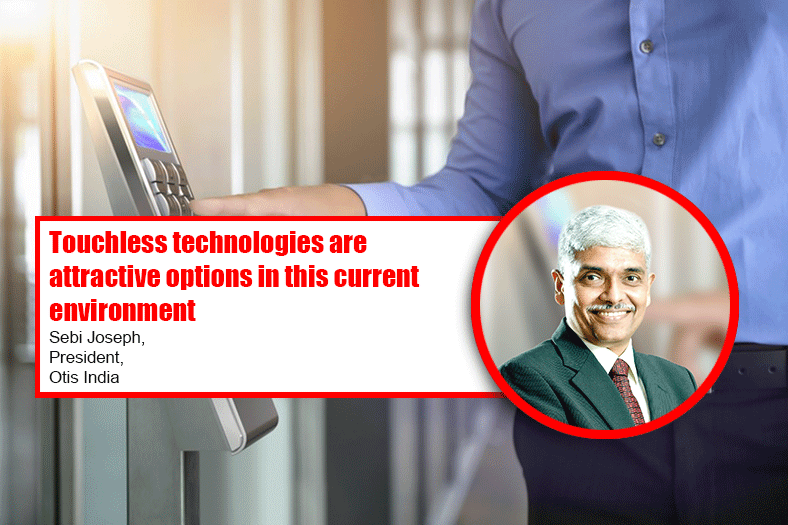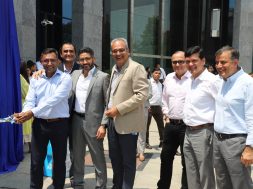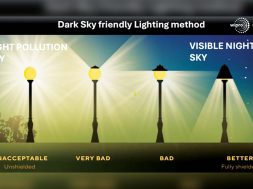Touchless technologies are attractive options in this current environment

Otis’ eCall app enables passengers to use their cell phone as their personal elevator call button and call an eCall-equipped elevator when approaching it says Sebi Joseph, President, Otis India.
When it comes to escalator and elevator solutions for commercial high-rises and residential highrises, are they specific in nature or same, kindly elucidate?
Elevators are made to order depending on the size of the hoist way. That’s one very important level of customization. Apart from size and dimension, elevator interiors, including wall panels, car operating panels, hall position indicators, hall operating panels and other interfaces offer a high degree of customization.
A building’s layout must also be considered when addressing traffic flow. This is especially key if the building is intended for multiple uses. When designing a tall building, it’s important to segment the building into zones so that floors intended for similar uses are close to each other. This can help alleviate ride times and reduce passenger traffic. In tall structures, we strive to ensure, smooth passenger flow and serve all floors, such that wait times are short after hitting the call button.
This is when it becomes important to segment the building into zones. If it is a mixed-use building, each elevator zone should serve different audiences – from visitors to office workers, to guests, to residents. Simply put, tall buildings need a solution to effectively manage pedestrian traffic. Otis’ CompassPlus addresses this need.
It uses data and smart technology to improve the passenger experience by reducing wait times and offering a faster and more efficient passenger journey. The system does this by evaluating realtime passenger traffic to improve flow and travel times in busy mid- and high-rise buildings. The system assigns passengers traveling to nearby floors to the same elevator car. This minimizes the number of stops per trip, car crowding, and passenger wait times. The CompassPlus system also offers customization and control, including interfacing with the building security systems and access controls and the design of the screen graphics.
At what stage of building a high-rise should the developer connect with the escalator and elevator specialists to ensure the best solutions are implemented?
Developers, architects, elevator consultants and elevator companies are collaborating better than ever to ensure the success of a project. The involvement of elevator companies and all parties coming together at the early stages helps shape the concept and design, with everyone’s points of view taken into consideration. This helps in designing a smooth and efficient passenger experience on the elevators. Elements like hoist way dimensions, expected occupants and visitors to the building, traffic patterns, code compliance, ride quality parameters, local project management capabilities and cross-functionalities etc. are things that must be addressed early-on and collaboratively.
What are some of the innovations you have implemented or suggest to ensure elevators and escalators remain disinfected and germ-free?
Otis is helping customers around the world prepare for the safe reopening and continued maintenance of their buildings. Touchless technologies are especially attractive options in this current environment. One example of touchless technology is the Otis eCall app.
The app enables passengers to use their cell phone as their personal elevator call button and call an eCall-equipped elevator when approaching it. This helps minimize the use of public access elevator buttons. The eCall app also gives building managers the flexibility to provide easy access for passengers. This will offer passengers a more seamless experience within their respective buildings.
In addition to our touchless technology offerings, we also offer an elevator and escalator purification products and services for customers. Some examples of these include:
Elevator purification fans: Elevators can be retrofitted with a fan technology that can inactivate microorganisms and filter dust within the cab. The fan integrates an ion generator and ultraviolet lamp to kill germs and filter dust within the cab. Handrail sanitizers: Fitted on handrails the module is designed to remove germs using ultraviolet light.
In the backdrop of the ongoing pandemic, what is your take on the market dynamics of escalators and elevators?
The Covid pandemic is evolving constantly, so it’s premature to comment on how things may change. That said, we are getting a lot of queries from customers for hands-free elevator access and sanitization procedures. In general, people are experiencing a lot of behavioural changes as part of coronavirus including Work from Home, focus on social distancing and hygiene. Which changes become “normal” is still to be determined.
What are some of the products you are banking on in this critical period?
At Otis, we were already in the midst of a digital transformation. From my perspective, touchless technologies are especially attractive options in this current environment. One example of our touchless technology is the Bluetooth enabled Otis eCall app. Beyond eCall, Otis also offers CompassPlus destination dispatching system.
The industry is also looking at remote maintenance as a possible solution. Remote service can improve elevator uptime and by keeping customers’ elevators running, the possibility of overcrowding in elevators due to limited availability is reduced supporting social distancing efforts. Further, it can help reduce the number of visitors in a building by reducing the number of in-person service calls.
Cookie Consent
We use cookies to personalize your experience. By continuing to visit this website you agree to our Terms & Conditions, Privacy Policy and Cookie Policy.









